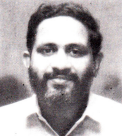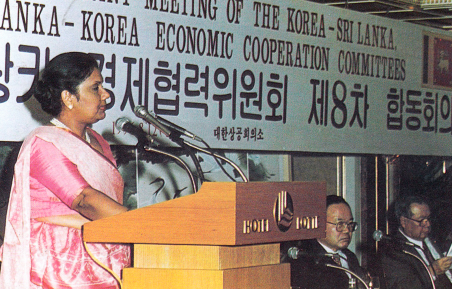
For long, Korea had been as sociated in the popular Sri Lankan mind with the Korean boom, the escalation of Sri Lanka’s rubber prices during the war between South and North Korea for three years from June 1950. That led to untold prosperity for Ceylon, as she was known then, a kind of golden afternoon to which older Sri Lankans still look back with undisguised nostalgia. In recent times, however, South Korea has invaded the popular consciousness as a major partner in Sri Lanka’s economic development and since of late a source of employment for Sri Lankans in Korea.
Thus it was not strange that Investment should have been the main theme of President Chandrika Bandaranaike Kumaratunge’s recent visit to the Republic of South Korea. In the talks, both with President Kim Young-Sam as well as the leaders of South Korean business, President Chandrika Bandaranaike Kumaratunge emphasized Sri Lanka’s potential as an investment location and the opportunities this will offer South Korea to break into the greater SAARC market.
Seoul was also the location at the same time for the eighth joint meeting of the Korea-Sri Lanka, Sri Lanka-Korea Economic Co-operation Committee meetings in Korea.
The President who addressed this gathering also met the biggest leaders of South Korean businesses and visited the Samsung and Daewoo factories to see for herself the impressive gains made by South Korean industry.
Wherever she spoke, President Kumaratunge expressed her great appreciation of the amazing economic revival which South Korea had been able to accomplish. Addressing the business and industrial leaders of Korea she said: “As a nation in Asia, we have watched with admiration how your people have brought this country to the level of newly industrialized countries in the world in a relatively short period of time. We, in Sri Lanka, are very enthusiastic about the Korean experience in which the public and private sectors engage in a dynamic corporate partnership in the achievement of the socio-economic goals of the nation”.
“When Korean investors look to better host country locations for investments, Sri Lankan industrialists at the same time look to attracting foreign investors to develop and expand their industrial ventures.”
The President noted that already 93 Korean private sector projects are in operation in Sri Lanka with a total investment of Rs6,284 million and providing employment to 45,681. In addition, 49 new projects are to begin with a total investment of Rs4,529 million and additional employment to 10,485.
Outlining Sri Lanka’s potential as an investment centre and the opportunities she has to offer Korean investors the President said: “When Korean investors look to better host country locations for investments, Sri Lankan industrialists at the same time look to attracting foreign investors to develop and expand their industrial ventures. South Korea is facing a shortage of low cost and high qual ity skills due to rapid development, Sri Lanka is facing the problem of unemployment of educated youth. At first glance, the challenges appear to be quite different. But these circumstances, I wish to say, are the most important factors conducive to strategic collaboration between Korea and Sri Lanka not only at Government level but also at industrial and commercial levels.

The President told her Korean audiences that her Government had embarked on a process of diversifying industry away from its present dependence on garments and textiles and into a range of value-added, high-tech industries. A package of fiscal incentives to reduce up-front cost of investment has been made available for existing and new companies to upgrade technology and undertake high technology investment so that they can remain industrially competitive. She identified the following areas as priority sectors for investments: agriculture, leather and rubber-based industries, ceramics and non-metallic mineral industries, skills-based and information-intensive industries, the tourist sector and light engineering and electronic industries. She said that with the country’s highly literate and easily trainable work force they had comparative advantages in developing these industries.
Another plank of the President’s message to Korean investors was the window investments in Sri Lanka will open for them to the emerging SAARC market. She said: “Sri Lanka attracts trade-driven flows of foreign investment, based on preferential access to a substantial South Asian market. The SAARC region has a population of 1.2 billion with an affluent middleclass nucleus of some 30 million. With the acceleration of the economic reform process in the sub-continent, especially in India, this market will continue to expand rapidly. The seven South Asian countries who are members of SAARC have recently decided to establish a South Asian Free Trade area by the year 2005.” Mr Lakshman R Watawala, the President of the Sri Lanka-Korea Economic Co-operation Committee said that a strong business delegation was visiting Korea from Sri Lanka. They had varied business interests including imports, exports and services, joint ventures and technology. Leading Korean companies could play a major role in helping Sri Lanka achieve good infrastructure including Industrial Estates exclusively for Korean investors. His delegation was interested in collaborations in the fields of automobile spare parts, fishing/ processing, garments/specialized garments, tourism-hotel/leisure projects, electrical/electronic products, jewellery, footwear, rubber-based products, services such as container terminal textiles and GEO textiles, furniture, ceramics, soft toys, air conditioning and refrigeration, confectionery, paper products and aluminium.
President Kumaratunge’s visit bore instant fruit when a high-powered delegation from the Heavy Industries Company arrived in Sri Lanka on August 26 just two weeks after her visit. The company which is known as Un Suh-Park is interested in the steel mill at Aturugiriya which is scheduled for privatization. The establishment of a 280 megawatt power and an oil refinery where the residue could be used for the production of energy are also among its agenda.
September will see a visit by Mr Kim Woo-Choon, the Chairman of Daewoo, one of the country’s biggest industrial giants with an amazing portfolio of products to its credit. Daewoo produces anything from electronic goods to ships. One of its subsidiary companies Keangnam has been Sri Lanka’s first Korean company and has played a major role in developing the country’s infrastructural facilities. It is interested in setting up a factory for manufacturing automobile spare parts which could service its automobile plant in Madras. The plans to reduce and finally eliminate the tariff structure under SAPTA will be a major incentive in impelling Daewoo since Sri Lanka would then become the ideal location for supplying its plant in India.
Another giant Hyundai has confirmed an agreement to set up a satellite communication network which will provide access to fixed, mobile and portable telephones worldwide. Their investment in Sri Lanka will be US$15 million.
Korean companies which have invested in Sri Lanka so far with the exception of Kabool (Lanka) are small or medium-sized companies. President Kumaratunge’s message to Korean entrepreneurs was that Sri Lanka was interested in mobilizing their skills for high-tech industries and developing her industrial infrastructure. The message seems to have gone home. Since Korea is already recognized as a major industrial power in Asia with global influence and Sri Lanka offers a fresh terrain of opportunities with her happy location at the foot of the vast Indian sub-continent and the SAARC conglomerate, it would appear as if a new chapter is about to be inscribed in Sri Lanka-Korea relations.


